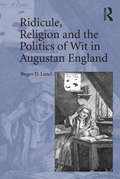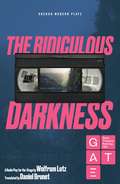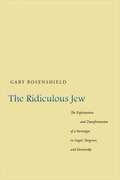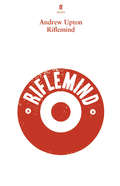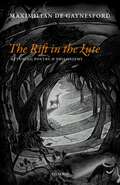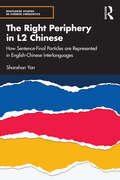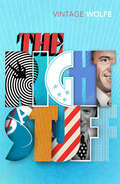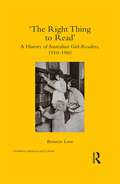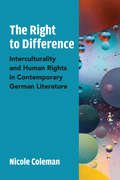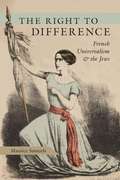- Table View
- List View
Ridicule, Religion and the Politics of Wit in Augustan England
by Roger D. LundArguing for the importance of wit beyond its use as a literary device, Roger D. Lund outlines the process by which writers in Restoration and eighteenth-century England struggled to define an appropriate role for wit in the public sphere. He traces its unpredictable effects in works of philosophy, religious pamphlets, and legal writing and examines what happens when literary wit is deliberately used to undermine the judgment of individuals and to destabilize established institutions of church and state. Beginning with a discussion of wit's association with deception, Lund suggests that suspicion of wit and the imagination emerges in attacks on the Restoration stage, in the persecution of The Craftsman, and in criticism directed at Thomas Hobbes's Leviathan and works by writers like the Earl of Shaftesbury, Thomas Woolston, and Thomas Paine. Anxieties about wit, Lund shows, were in part responsible for attempts to suppress new communal venues such as coffee houses and clubs and for the Church's condemnation of the seditious pamphlets made possible by the lapse of the Licensing Act in 1695. Finally, the establishment's conviction that wit, ridicule, satire, and innuendo are subversive rhetorical forms is glaringly at play in attempts to use libel trials to translate the fear of wit as a metaphorical transgression of public decorum into an actual violation of the civil code.
The Ridiculous Darkness (Oberon Modern Plays)
by Wolfram Lotz“I have a right to appear here. Otherwise, who will listen to me? Where should I talk about myself, if not here?” Ultimo has a degree in piracy from Mogadishu University of Applied Sciences. Tofdau won’t rest until his story’s told. Sergeant Pellner and Officer Dorsch are sailing up the Hindu Kush in search of Lieutenant Colonel Deutinger in the rainforest of Afghanistan. And at his parents’ home in Bad Rippoldsau, Wolfram Lotz is experiencing writer’s block. Critically acclaimed dark comedy The Ridiculous Darkness, by award-winning German playwright Wolfram Lotz, is a surreal, hilarious and powerful response to Heart of Darkness and Apocalypse Now that invites us to rethink colonial narratives, confront our ideas of each other and question what we imagine is in the darkness. Four black femmes. Three revered White Male Writers. Two classic works. A radical deconstruction.
The Ridiculous Jew: The Exploitation and Transformation of a Stereotype in Gogol, Turgenev, and Dostoevsky
by Gary RosenshieldThis book is a study devoted to exploring the use of a Russian version of the Jewish stereotype (the ridiculous Jew) in the works of three of the greatest writers of the nineteenth century. Rosenshield does not attempt to expose the stereotype—which was self-consciously and unashamedly employed. Rather, he examines how stereotypes are used to further the very different artistic, cultural, and ideological agendas of each writer. What distinguishes this book from others is that it explores the problems that arise when an ethnic stereotype is so fully incorporated into a work of art that it takes on a life of its own, often undermining the intentions of its author as well as many of the defining elements of the stereotype itself. With each these writers, the Jewish stereotype precipitates a literary transformation, taking their work into an uncomfortable space for the author and a challenging one for readers.
Riflemind
by Andrew UptonTwenty years after their frontman, John, walked off stage for good, the ironic rock band Riflemind are set to get together again. For John, a reunion might be his second chance; for his wife, Lyn, it could be the end of the world as she knows it . . . As the band descend upon John's country manor, this weekend fast becomes the ultimate test of talent, friendship and loyalty.Originally produced by Sydney Theatre Company, Riflemind received its UK premiere at the Trafalgar Studio, London, in September 2008.
The Rift in The Lute: Attuning Poetry and Philosophy
by Maximilian de GaynesfordWhat is it for poetry to be serious and to be taken seriously? What is it to be open to poetry, exposed to its force, attuned to what it says and alive to what it does? These are important questions that call equally on poetry and philosophy. But poetry and philosophy, notoriously, have an ancient quarrel. Maximilian de Gaynesford sets out to understand and convert their mutual antipathy into something mutually enhancing, so that we can begin to answer these and other questions. The key to attuning poetry and philosophy lies in the fact that poetic utterances are best appreciated as doing things. For it is as doing things that the speech act approach in analytic philosophy of language tries to understand all utterances. Taking such an approach, this book offers ways to enhance our appreciation of poetry and to develop our understanding of philosophy. It explores work by a range of poets from Chaucer to Geoffrey Hill and J. H. Prynne, and culminates in an extended study of Shakespeare's Sonnets. What work does poetry set itself, and how does this determine the way it is to be judged? What do poets commit themselves to, and what they may be held responsible for? What role does a poet have, or their audience, or their context, in determining the meaning of a poem, what work it is able to achieve? These are the questions that an attuned approach is able to ask and answer.
The Rift in The Lute: Attuning Poetry and Philosophy
by Maximilian de GaynesfordWhat is it for poetry to be serious and to be taken seriously? What is it to be open to poetry, exposed to its force, attuned to what it says and alive to what it does? These are important questions that call equally on poetry and philosophy. But poetry and philosophy, notoriously, have an ancient quarrel. Maximilian de Gaynesford sets out to understand and convert their mutual antipathy into something mutually enhancing, so that we can begin to answer these and other questions. The key to attuning poetry and philosophy lies in the fact that poetic utterances are best appreciated as doing things. For it is as doing things that the speech act approach in analytic philosophy of language tries to understand all utterances. Taking such an approach, this book offers ways to enhance our appreciation of poetry and to develop our understanding of philosophy. It explores work by a range of poets from Chaucer to Geoffrey Hill and J. H. Prynne, and culminates in an extended study of Shakespeare's Sonnets. What work does poetry set itself, and how does this determine the way it is to be judged? What do poets commit themselves to, and what they may be held responsible for? What role does a poet have, or their audience, or their context, in determining the meaning of a poem, what work it is able to achieve? These are the questions that an attuned approach is able to ask and answer.
The Right Periphery in L2 Chinese: How Sentence-Final Particles are Represented in English-Chinese Interlanguages (Routledge Studies in Chinese Linguistics)
by Shanshan YanThe Right Periphery in L2 Chinese is among the first books to try to incorporate both advanced linguistic and acquisition perspectives to show how eight sentence-final particles are represented in English-speaking learners’ L2 Chinese. This book will inform researchers of the general construction of the right periphery in L2 grammars. Drawing on up-to-date theoretical frameworks and findings from advanced empirical studies, it sketches the general picture of the periphery that these particles occupy in English-Chinese interlanguages. Readers will grasp the problems and difficulties, and particularly the ambiguities, which learners of Chinese must grapple with in the process of acquiring sentence-final particles. Possible influential factors underlying the acquisition process are explicitly discussed as well. Researchers will also find insights in the advanced methodologies and statistics that are used to study Chinese. The book will be illuminating for researchers interested in SLA, linguists of generative theories, and educators teaching Chinese as a second/foreign language.
The Right Periphery in L2 Chinese: How Sentence-Final Particles are Represented in English-Chinese Interlanguages (Routledge Studies in Chinese Linguistics)
by Shanshan YanThe Right Periphery in L2 Chinese is among the first books to try to incorporate both advanced linguistic and acquisition perspectives to show how eight sentence-final particles are represented in English-speaking learners’ L2 Chinese. This book will inform researchers of the general construction of the right periphery in L2 grammars. Drawing on up-to-date theoretical frameworks and findings from advanced empirical studies, it sketches the general picture of the periphery that these particles occupy in English-Chinese interlanguages. Readers will grasp the problems and difficulties, and particularly the ambiguities, which learners of Chinese must grapple with in the process of acquiring sentence-final particles. Possible influential factors underlying the acquisition process are explicitly discussed as well. Researchers will also find insights in the advanced methodologies and statistics that are used to study Chinese. The book will be illuminating for researchers interested in SLA, linguists of generative theories, and educators teaching Chinese as a second/foreign language.
The Right Start to Phonics: A Guide to Supporting Excellence in Early Phonics
by Rose BlairIf children are to access all phonics teaching effectively, they first need to know how to tune into and manipulate the sounds specifically needed for reading. The Right Start to Phonics shows readers how they can support children in gaining the skills they need to listen with accuracy, to differentiate between, manipulate and understand the sounds we hear. This experience will give them the knowledge and understanding needed to hear letter sounds and blend them together to eventually read words.Drawing on the latest research, the book shows how Early Phonics can be embedded across your provision and fit into the daily routine of any setting or school. Part One explores the role of play, the adult and the learning environment in supporting early phonics and listening skills. This is followed by a wealth of easy-to-use activities to support the development and refinement of these hugely important skills in our youngest children. All the activities are simple to implement with easily sourced resources and cover a range of early phonic skills.Full of playful, active and fun ideas to help young children develop the auditory skills they need to access the phonic code, this is essential reading for all early years and primary educators and parents.
The Right Start to Phonics: A Guide to Supporting Excellence in Early Phonics
by Rose BlairIf children are to access all phonics teaching effectively, they first need to know how to tune into and manipulate the sounds specifically needed for reading. The Right Start to Phonics shows readers how they can support children in gaining the skills they need to listen with accuracy, to differentiate between, manipulate and understand the sounds we hear. This experience will give them the knowledge and understanding needed to hear letter sounds and blend them together to eventually read words.Drawing on the latest research, the book shows how Early Phonics can be embedded across your provision and fit into the daily routine of any setting or school. Part One explores the role of play, the adult and the learning environment in supporting early phonics and listening skills. This is followed by a wealth of easy-to-use activities to support the development and refinement of these hugely important skills in our youngest children. All the activities are simple to implement with easily sourced resources and cover a range of early phonic skills.Full of playful, active and fun ideas to help young children develop the auditory skills they need to access the phonic code, this is essential reading for all early years and primary educators and parents.
The Right Stuff (Great Books Ser.)
by Tom WolfeA wildly vivid and entertaining chronicle of America's manned space program, from the author of The Electric Kool-Aid Acid TestWITH AN INTRODUCTION BY US ASTRONAUT SCOTT KELLY‘What is it’ asks Tom Wolfe, ‘that makes a man willing to sit on top of an enormous Roman Candle…and wait for someone to light the fuse?’ Arrogance? Stupidity? Bravery? Courage? Or, simply, that quality we call 'the right stuff'?A monument to the men who battled to beat the Russians into space, The Right Stuff is a voyage into the mythology of the American space program, and a dizzying dive into the sweat, fear, beauty and danger of being on the white-hot edge of history in the making.‘Tom Wolfe at his very best… Learned, cheeky, risky, touching, tough, compassionate, nostalgic, worshipful, jingoistic...The Right Stuff is superb’ - New York Times Book Review
‘The Right Thing to Read’: A History of Australian Girl-Readers, 1910-1960
by Bronwyn Lowe‘The Right Thing to Read’: A History of Australian Girl-Readers, 1910-1960 explores the reading habits, identity, and construction of femininity of Australian girls aged between ten and fourteen from 1910 to 1960. It investigates changing notions of Australian girlhood across the period, and explores the ways that parents, teachers, educators, journalists and politicians attempted to mitigate concerns about girls’ development through the promotion of ‘healthy’ literature. The book also addresses the influence of British publishers to Australian girl-readers and the growing importance of Australian publishers throughout the period. It considers the rise of Australian literary nationalism in the global context, and the increasing prominence of Australian literature in the period after the Second World War. It also shows how access to reading material improved for girls over the first half of the last century.
‘The Right Thing to Read’: A History of Australian Girl-Readers, 1910-1960
by Bronwyn Lowe‘The Right Thing to Read’: A History of Australian Girl-Readers, 1910-1960 explores the reading habits, identity, and construction of femininity of Australian girls aged between ten and fourteen from 1910 to 1960. It investigates changing notions of Australian girlhood across the period, and explores the ways that parents, teachers, educators, journalists and politicians attempted to mitigate concerns about girls’ development through the promotion of ‘healthy’ literature. The book also addresses the influence of British publishers to Australian girl-readers and the growing importance of Australian publishers throughout the period. It considers the rise of Australian literary nationalism in the global context, and the increasing prominence of Australian literature in the period after the Second World War. It also shows how access to reading material improved for girls over the first half of the last century.
The Right to Difference: Interculturality and Human Rights in Contemporary German Literature
by Nicole ColemanThe Right to Difference examines novels that depict human rights violations in order to explore causes of intergroup violence within diverse societies, using Germany as a test case. In these texts, the book shows that an exaggeration of difference between minority and majority groups leads to violence. Germany has become increasingly diverse over the past decades due to skilled labor migration and refugee movements. In light of this diversity, this book’s approach transcends a divide between migrant and post-migrant German literature on the one hand and a national literature on the other hand. Addressing competing definitions of national identity as well as the contest between cultural homogeneity and diversity, the author redefines the term “intercultural literature.” It becomes not a synonym for authors who do not belong to a national literature, such as migrant writers, but a way of reading literature with an intercultural lens. This book builds a theory of intercultural literature that focuses on the multifaceted nature of identity, in which ethnicity represents only one of many characteristics defining individuals. To develop intercultural competence, one needs to adopt a complex image of individuals that allows for commonalities and differences by complicating the notion of sharp contrasts between groups. Revealing the affective allegiances formed around other characteristics (gender, profession, personal motivations, relationships, and more) allows for similarities that grouping into large, homogeneous, and seemingly exclusive entities conceals. Eight novels analyzed in this book remember and reveal human rights violations, such as genocide, internment and torture, violent expulsion, the reasons for fleeing a country, dangerous flight routes and the difficulty of settling in a new country. Some of these novels allow for affective identification with diverse characters and cast the protagonists as individuals with plural perspectives and identities rather than monolithic members of one large national or ethnic group, whereas others emphasize the commonalities of all people. Ultimately, the author makes the case for German Studies to contribute to an antiracist approach to diversity by redefining what it means to be German and establishing difference as a fundamental human right
The Right to Difference: French Universalism and the Jews
by Maurice SamuelsUniversal equality is a treasured political concept in France, but recent anxiety over the country’s Muslim minority has led to an emphasis on a new form of universalism, one promoting loyalty to the nation at the expense of all ethnic and religious affiliations. This timely book offers a fresh perspective on the debate by showing that French equality has not always demanded an erasure of differences. Through close and contextualized readings of the way that major novelists, philosophers, filmmakers, and political figures have struggled with the question of integrating Jews into French society, Maurice Samuels draws lessons about how the French have often understood the universal in relation to the particular. Samuels demonstrates that Jewish difference has always been essential to the elaboration of French universalism, whether as its foil or as proof of its reach. He traces the development of this discourse through key moments in French history, from debates over granting Jews civil rights during the Revolution, through the Dreyfus Affair and Vichy, and up to the rise of a “new antisemitism” in recent years. By recovering the forgotten history of a more open, pluralistic form of French universalism, Samuels points toward new ways of moving beyond current ethnic and religious dilemmas and argues for a more inclusive view of what constitutes political discourse in France.
The Right to Difference: French Universalism and the Jews
by Maurice SamuelsUniversal equality is a treasured political concept in France, but recent anxiety over the country’s Muslim minority has led to an emphasis on a new form of universalism, one promoting loyalty to the nation at the expense of all ethnic and religious affiliations. This timely book offers a fresh perspective on the debate by showing that French equality has not always demanded an erasure of differences. Through close and contextualized readings of the way that major novelists, philosophers, filmmakers, and political figures have struggled with the question of integrating Jews into French society, Maurice Samuels draws lessons about how the French have often understood the universal in relation to the particular. Samuels demonstrates that Jewish difference has always been essential to the elaboration of French universalism, whether as its foil or as proof of its reach. He traces the development of this discourse through key moments in French history, from debates over granting Jews civil rights during the Revolution, through the Dreyfus Affair and Vichy, and up to the rise of a “new antisemitism” in recent years. By recovering the forgotten history of a more open, pluralistic form of French universalism, Samuels points toward new ways of moving beyond current ethnic and religious dilemmas and argues for a more inclusive view of what constitutes political discourse in France.
The Right to Difference: French Universalism and the Jews
by Maurice SamuelsUniversal equality is a treasured political concept in France, but recent anxiety over the country’s Muslim minority has led to an emphasis on a new form of universalism, one promoting loyalty to the nation at the expense of all ethnic and religious affiliations. This timely book offers a fresh perspective on the debate by showing that French equality has not always demanded an erasure of differences. Through close and contextualized readings of the way that major novelists, philosophers, filmmakers, and political figures have struggled with the question of integrating Jews into French society, Maurice Samuels draws lessons about how the French have often understood the universal in relation to the particular. Samuels demonstrates that Jewish difference has always been essential to the elaboration of French universalism, whether as its foil or as proof of its reach. He traces the development of this discourse through key moments in French history, from debates over granting Jews civil rights during the Revolution, through the Dreyfus Affair and Vichy, and up to the rise of a “new antisemitism” in recent years. By recovering the forgotten history of a more open, pluralistic form of French universalism, Samuels points toward new ways of moving beyond current ethnic and religious dilemmas and argues for a more inclusive view of what constitutes political discourse in France.
The Right to Difference: French Universalism and the Jews
by Maurice SamuelsUniversal equality is a treasured political concept in France, but recent anxiety over the country’s Muslim minority has led to an emphasis on a new form of universalism, one promoting loyalty to the nation at the expense of all ethnic and religious affiliations. This timely book offers a fresh perspective on the debate by showing that French equality has not always demanded an erasure of differences. Through close and contextualized readings of the way that major novelists, philosophers, filmmakers, and political figures have struggled with the question of integrating Jews into French society, Maurice Samuels draws lessons about how the French have often understood the universal in relation to the particular. Samuels demonstrates that Jewish difference has always been essential to the elaboration of French universalism, whether as its foil or as proof of its reach. He traces the development of this discourse through key moments in French history, from debates over granting Jews civil rights during the Revolution, through the Dreyfus Affair and Vichy, and up to the rise of a “new antisemitism” in recent years. By recovering the forgotten history of a more open, pluralistic form of French universalism, Samuels points toward new ways of moving beyond current ethnic and religious dilemmas and argues for a more inclusive view of what constitutes political discourse in France.
The Right to Difference: French Universalism and the Jews
by Maurice SamuelsUniversal equality is a treasured political concept in France, but recent anxiety over the country’s Muslim minority has led to an emphasis on a new form of universalism, one promoting loyalty to the nation at the expense of all ethnic and religious affiliations. This timely book offers a fresh perspective on the debate by showing that French equality has not always demanded an erasure of differences. Through close and contextualized readings of the way that major novelists, philosophers, filmmakers, and political figures have struggled with the question of integrating Jews into French society, Maurice Samuels draws lessons about how the French have often understood the universal in relation to the particular. Samuels demonstrates that Jewish difference has always been essential to the elaboration of French universalism, whether as its foil or as proof of its reach. He traces the development of this discourse through key moments in French history, from debates over granting Jews civil rights during the Revolution, through the Dreyfus Affair and Vichy, and up to the rise of a “new antisemitism” in recent years. By recovering the forgotten history of a more open, pluralistic form of French universalism, Samuels points toward new ways of moving beyond current ethnic and religious dilemmas and argues for a more inclusive view of what constitutes political discourse in France.
The Right to Difference: French Universalism and the Jews
by Maurice SamuelsUniversal equality is a treasured political concept in France, but recent anxiety over the country’s Muslim minority has led to an emphasis on a new form of universalism, one promoting loyalty to the nation at the expense of all ethnic and religious affiliations. This timely book offers a fresh perspective on the debate by showing that French equality has not always demanded an erasure of differences. Through close and contextualized readings of the way that major novelists, philosophers, filmmakers, and political figures have struggled with the question of integrating Jews into French society, Maurice Samuels draws lessons about how the French have often understood the universal in relation to the particular. Samuels demonstrates that Jewish difference has always been essential to the elaboration of French universalism, whether as its foil or as proof of its reach. He traces the development of this discourse through key moments in French history, from debates over granting Jews civil rights during the Revolution, through the Dreyfus Affair and Vichy, and up to the rise of a “new antisemitism” in recent years. By recovering the forgotten history of a more open, pluralistic form of French universalism, Samuels points toward new ways of moving beyond current ethnic and religious dilemmas and argues for a more inclusive view of what constitutes political discourse in France.
Right to Mourn: Trauma, Empathy, and Korean War Memorials
by Suhi ChoiIn the highly politicized memory space of postwar South Korea, many families have been deprived of their right to mourn loved ones lost in the Korean War. Only since the 1990s has the government begun to acknowledge the atrocities committed by South Korean and American troops that resulted in large numbers of civilian casualties. The Truth and Reconciliation Committee, new laws honoring victims, and construction of monuments and memorials have finally opened public spaces for mourning. In Right to Mourn, Suhi Choi explores this new context of remembering in which memories that have long been private are brought into official sites. As the generation that once carried these memories fades away, Choi poses an increasingly critical question: can a memorial communicate trauma and facilitate mourning? Through careful examination of recently built Korean War memorials (the Jeju April 3 Peace Park, the Memorial for the Gurye Victims of Yosun Killings, and the No Gun Ri Peace Park), Right to Mourn provokes readers to look at the nearly seven-decade-old war within the most updated context, and shows how suppressed trauma manifests at the transient interactions among bodies, objects, and rituals at the sites of these memorials.
Right to Mourn: Trauma, Empathy, and Korean War Memorials
by Suhi ChoiIn the highly politicized memory space of postwar South Korea, many families have been deprived of their right to mourn loved ones lost in the Korean War. Only since the 1990s has the government begun to acknowledge the atrocities committed by South Korean and American troops that resulted in large numbers of civilian casualties. The Truth and Reconciliation Committee, new laws honoring victims, and construction of monuments and memorials have finally opened public spaces for mourning. In Right to Mourn, Suhi Choi explores this new context of remembering in which memories that have long been private are brought into official sites. As the generation that once carried these memories fades away, Choi poses an increasingly critical question: can a memorial communicate trauma and facilitate mourning? Through careful examination of recently built Korean War memorials (the Jeju April 3 Peace Park, the Memorial for the Gurye Victims of Yosun Killings, and the No Gun Ri Peace Park), Right to Mourn provokes readers to look at the nearly seven-decade-old war within the most updated context, and shows how suppressed trauma manifests at the transient interactions among bodies, objects, and rituals at the sites of these memorials.
A Right to Offend: Free Expression In The Twenty-first Century
by Brian WinstonOver the past two decades, there have been a series of events that have brought into question the concept and practice of free expression. In this new book, Winston provides an account of the current state of freedom of expression in the western world. He analyses all the most pertinent cases of conflict during the last two decades - including the fatwa against Salman Rushdie, the incident of the Danish cartoons and offended celebrities - examining cultural, legal and journalistic aspects of each case. A Right to Offend offers us a deeper understanding of the increasingly threatening environment in which free speech operates and is defended, as well as how it informs and is central to journalism practice and media freedom more generally. It is important reading for all those interested in freedom of expression in the twenty-first century.
A Right to Offend: Free Expression In The Twenty-first Century
by Brian WinstonOver the past two decades, there have been a series of events that have brought into question the concept and practice of free expression. In this new book, Winston provides an account of the current state of freedom of expression in the western world. He analyses all the most pertinent cases of conflict during the last two decades - including the fatwa against Salman Rushdie, the incident of the Danish cartoons and offended celebrities - examining cultural, legal and journalistic aspects of each case. A Right to Offend offers us a deeper understanding of the increasingly threatening environment in which free speech operates and is defended, as well as how it informs and is central to journalism practice and media freedom more generally. It is important reading for all those interested in freedom of expression in the twenty-first century.
Right to the City Novels in Turkish Literature from the 1960s to the Present (Literary Urban Studies)
by N. Buket CengizRight to the City Novels in Turkish Literature from the 1960s to the Present analyses the representation of rural migration to Istanbul in literature, placing Henri Lefebvre’s concept of the right to the city at the centre of the argument. Using a framework of critical urban theory, the book examines Orhan Kemal’s Gurbet Kuşları [The Homesick Birds] (1962); Muzaffer İzgü’s Halo Dayı ve İki Öküz [Uncle Halo and Two Oxen] (1973); Latife Tekin’s Berci Kristin Çöp Masalları [Berji Kristin: Tales From the Garbage Hills] (1984); Metin Kaçan’s Ağır Roman [Heavy Roman(i)] (1990); Ayhan Geçgin’s Kenarda [On the Periphery] (2003); Hatice Meryem’s İnsan Kısım Kısım, Yer Damar Damar [It Takes All Kinds] (2008); and Orhan Pamuk’s Kafamda Bir Tuhaflık [A Strangeness in My Mind] (2014) in the historical context as regards rural migration to Istanbul, urbanization of migrants, and anti-migrant nostalgia. Situating these works as a counterpoint to nostalgic novels and categorising them as right to the city novels, the book aims to offer a conceptual framework that can be implemented on internal as well as international migration in other global(ising) cities; and on cultural products other than literature, such as film.
